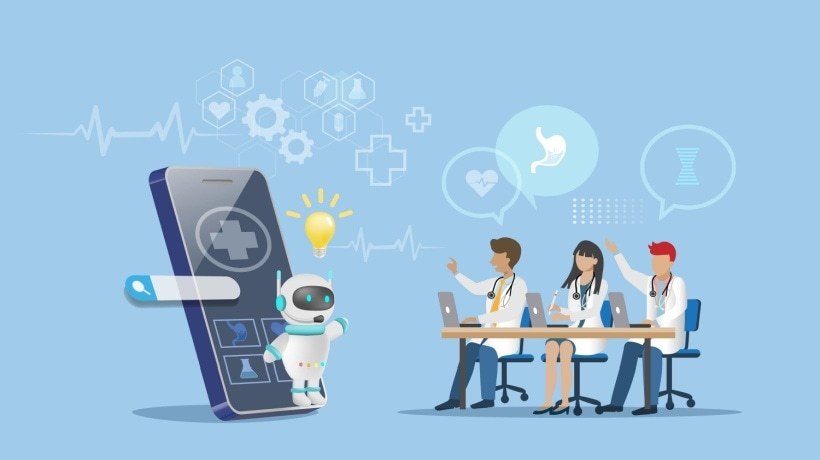What AI In Healthcare Means For Med Schools
Artificial intelligence (AI) is transforming nearly every corner of healthcare—from diagnostics to patient management—and medical education is no exception. With the market for AI in healthcare rapidly expanding, adopting AI in medical education has become essential for training tomorrow's healthcare professionals. Luckily, by embracing technologies like adaptive learning platforms and virtual simulations, medical schools can help prepare students for an AI-driven future in healthcare. But how exactly do AI tools support medical students and educators? And what does this look like in practice? I've got answers and quite a few examples for you. So, let's dive in.
In this article, you'll find...
- The Role Of AI In Medical Education
- What Are The Benefits Of Using AI In Medical Education?
- 5 Examples Of How Schools Are Using AI In Medical Education
- Ethical Considerations Of AI In Medical Education
- The Future Of Medical Education Is Human-Centered And AI-Assisted
The Role Of AI In Medical Education
Since AI has revolutionized the healthcare sector and the AI in healthcare market is projected to reach over $187 billion by 2030, it's only natural that medical schools would look to integrate this transformative and far-reaching technology into their classrooms. In medical education, AI technologies include:
- Clinical decision support systems.
- Intelligent tutoring systems.
- Automated assessment tools.
- Adaptive learning platforms.
- AI-powered virtual simulation tools.
These technologies aim to enhance learning and equip students with the knowledge and skills they need to deliver timely, high-quality patient care. At the same time, such tools will ensure students are prepared for a workforce already using AI for an increasing number of tasks. And yet, many medical schools have been slow to adopt AI. A study found that only 14% of medical schools have developed a formal generative AI curriculum. That's compared with 60% of undergraduate programs.
If medical educators are to be convinced of both the value and necessity of AI in the classroom, they need evidence of AI's positive impact on students and faculty. On that note, let's get into the research-backed benefits of using AI in medical education.
What Are The Benefits Of Using AI In Medical Education?
AI benefits medical students and faculty by:
- Streamlining administrative tasks
A "Time For Class 2025" report found that AI helped professors reduce time spent on course-related research, grading, providing tailored feedback, and communicating with students. - Accelerating learning
According to a research study on medical students' attitudes toward AI in education, 60.3% of students agreed that AI learning optimized their study time. 65.7% also said that AI helped them understand medical concepts faster than traditional books and lectures. - Supporting clinical decision-making
Students can use AI to help diagnose standardized patients and hone their decision-making skills in preparation for real-world patients. Per an American Medical Association (AMA) survey, 12% of working physicians already use AI for real-life assistive diagnosis. - Future-proofing medical students' skills
The same AMA survey found that 66% of physicians use healthcare AI. If faculty want to prepare students for the job market, they should teach students how to leverage it effectively and ethically.
5 Examples Of How Schools Are Using AI In Medical Education
Knowing the different use cases of AI in medical education brings school leaders this much closer to successfully applying the technology. Here are a few ways AI can be used at medical schools.
1) To Strengthen Clinical Skills
Medical students must put their clinical skills to the test in interactions with standardized patients. Here, they develop diagnosis and treatment plans for patients and then explain their reasoning to faculty members in subsequent debriefing sessions. These debriefings can be challenging for students. This is because students have to break down, step by step, why they reached a certain diagnosis.
AI diagnostic tools can demystify the process, though, by giving students a better understanding of clinical reasoning. Take Harvard Medical School's Dr. CaBot, for example. It's an AI diagnostic system distinguished by its ability to provide differential diagnosis. The system guides students through challenging medical cases, giving them insight into how to reason through their own cases and enhancing students' clinical skills in the process.
2) To Optimize Assessment And Feedback
AI is also a great tool for assessing student performance and providing personalized feedback. Adaptive learning platforms, for example, use AI to create tests that adjust questions based on students' responses. These AI-driven assessments provide valuable insights to instructors.
One such instructor is Anastasiya Lipnevich, a professor of educational psychology at the City University of New York (CUNY). She said in a National Board of Medical Examiners webinar that AI assessments "can inform us that [a particular] student makes mistakes in these domains," for example. Adaptive learning platforms also provide personalized feedback to students, enhancing student engagement and knowledge retention, according to a research study.
3) To Support Experiential Learning
Instead of settling for mannequins, educators can design more immersive learning experiences by using AI simulation tools with Virtual Reality (VR) and Augmented Reality (AR) features. Virtual Reality uses headsets to immerse users in a computer-generated world. Meanwhile, Augmented Reality brings digital elements into the user's live view via a smartphone or smart glasses.
The University of Virginia's Department of Anesthesiology is leveraging the former technology by incorporating a Virtual Reality training platform into its curriculum. The platform allows students to use headsets and controllers to interact with digital patients while following instructions from an AI-powered virtual facilitator.
4) To Enhance Curriculum Development
AI can modernize traditional medical education by leveraging analytics to inform curricula. For example, Machine Learning models can analyze student performance data and provide recommendations on how to tailor course content to the needs of learners. AI can also help generate course material.
At the University of Miami's Miller School of Medicine, faculty used generative AI to create a "large library of patient simulation cases," fact-checking them for errors or biases. This gives medical students more diverse examples than the ones found in traditional textbooks, preparing them for the various kinds of patients they'll encounter in real hospitals.
5) To Amplify Research Efforts
Students and faculty can use AI to conduct groundbreaking research, ultimately leading to new medical treatments and technologies that can improve our quality of life. Just take a look at the Yale School of Medicine. The school houses the Yale Hematology Tissue Bank, which provides researchers with patient samples for the study of hematologic diseases.
Yale faculty built a hematology-specific Large Language Model to speed up the process of extracting clinical information from those samples. Using the model, faculty hope to build a hematology research database that researchers can search using natural language questions. According to one of the researchers who helped build the Large Language Model, the goal of the AI tool is to "spur biomedical research to improve the care for patients with blood disorders."
Ethical Considerations Of AI In Medical Education
Using AI in medical education raises several ethical questions concerning:
- Privacy and data security
AI requires handling sensitive student and, potentially, patient information. Without proper safeguards, such data will be vulnerable to breaches. - Bias and fairness
A research article published in The Milbank Quarterly found that AI algorithms can show biases that could hurt Black patients. So, for example, students who use biased AI algorithms to help diagnose standardized patients could misdiagnose patients from this racial-ethnic group. - Transparency and explainability
Students and faculty must understand how AI comes to its diagnostic and treatment decisions. Otherwise, the lack of transparency and decipherability will hinder effective and ethical implementation of AI technology. - Human expertise and oversight
AI must be used to support, not replace, human skills and judgment. Overreliance on AI for clinical reasoning, curriculum development, assessment, and other aspects of medical education will erode students' and faculty members' critical thinking and decision-making skills.
Medical schools should create clear guidelines to address all of these ethical concerns. They should also provide policies on proper AI usage that are informed by insights from educators, students, ethicists, researchers, and policymakers.
School leaders can look to other medical schools to inform their own policies. For example, Harvard Medical School, The University at Buffalo's Jacobs School of Medicine and Biomedical Sciences, and Boston University's Chobanian & Avedisian School of Medicine are among dozens of schools that have posted their AI guidelines online.
The Future Of Medical Education Is Human-Centered And AI-Assisted
AI has the potential to enhance medical education—and it's already doing so based on the examples we've looked at. Students are using it as a study tool and to strengthen their clinical skills. Meanwhile, faculty members are leveraging the technology for assessment and curriculum development. That said, medical schools should guide students and faculty members' usage by providing clear, comprehensive AI policies. This ensures usage doesn't turn into overreliance and that human expertise remains at the forefront—just as it should in real-life hospitals and care clinics. The future of healthcare may be AI-assisted, but it will always be human-centered. So as students' vehicle to a career in healthcare, medical schools should uphold this philosophy.









